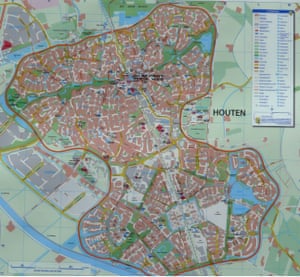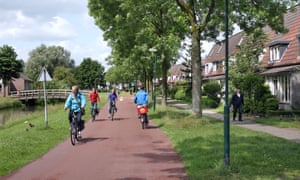Before I’m out of bed, our 15-year-old slams the door and jumps on her bike, heading for school and meeting friends along the way.
Last week, our eight and 13-year-olds attended four parties between them. They scoffed the obligatory birthday sugar, went bowling, shot lasers, played mini-golf and patted sheep – travelling to and from all of these activities by bike. There wasn’t a helmet or scrap of hi-vis between them.
This is daily life in Houten, a suburb of Utrecht in the Netherlands. Spend any time here and you’ll soon see hordes of kids riding their bikes to gym lessons, parties, after-school care or sports activities through wind, rain or shine. One of my favourite Dutch expressions is “Jij bent niet van suiker gamaakt” (“You’re not made of sugar”), meaning you won’t dissolve in the rain – so get on your bike.
This lifestyle drew us to the Netherlands from Britain. After 15 years of dreaming – via Sydney, London and Norwich – we went in search of a more cycle-friendly city.

Now we’re Houtenaars, citizens of a world-renowned cycling suburb studied by future town planners around the globe. Houten has been on the map since Roman times, but modern development began in the late 1960s as an overspill for fast-growing Utrecht.
Architect Rob Derks designed Houten to prioritise pedestrians and cyclists over motorists. A ring road circles the suburb, and residential districts within are only accessible to cars through these roads on the edge of town. Instead, there is an extensive network of paths and cycle lanes connecting these areas.
Sharp bends and low speed limits mean roads are intentionally difficult to navigate by motor vehicle: in Houten, cars are slightly unwelcome guests. Unlike drivers, cyclists and walkers can travel direct, making a two-minute walk or ride a 10-minute trip by car, for example.
It works: an estimated 98% of Houten households own at least one bike, with an average of 3.4 bikes per household. While many work trips are made by car – particularly journeys out of the city – cycling is by far the most popular mode of transport. A report by the ITDP found 53% of residents travel to the grocery shop by bike or on foot. This rises to 79% for errands like visiting the bank or getting a haircut, and for visiting friends and family in Houten.

Residents do own cars – although rarely more than one, and some prefer to use a car-share company. Children ride bikes as soon as they can walk, people with disabilities move freely and independently, elderly people cycle everywhere and if they start to feel unsafe on two wheels, they swap them for three. Immigrants who’ve never had a bicycle are taught to ride.
Every now and again we get a strange sense of guilt about loving this perfectly planned life. We watch visitors’ first anxious sense that they’ve fallen into the Truman Show quickly disappear as they realise just how upside-down their perception of a “normal” city is.
Here, good public space and architecture is for everyone. There’s a large amount of social housing in Houten but you’d be hard-pressed to pick it out because there’s little written into these buildings to declare who has money and who doesn’t. The shared architecture and wonderful functionality frees people to be who they are. Far from being claustrophobic, it’s liberating.
My family were lucky – we had the Dutch passport my father-in-law handed down to his Australian-born children when his own family left post-war Holland.
Our daughters were old enough to know what they were leaving behind in Norwich. They may have hated us the day we dropped them into a local Dutch school with no language, but they survived. They missed their friends at first but now they love their independence, the clean air and Houten’s close community. On visits to family in London and Australia, all three kids are astounded at how much time they have to spend in the car, how noisy everything is and how dependent children are on their parents.
Not everyone has the chance to make the choices we did. But none of what Houten stands for is radical or alternative. This Dutch city’s choice to move away from the car, to clear the air, to invest in healthy individuals, is not an unreachable ideal.
Houten is the future many of us trapped in car-focused societies dream of, but it’s happening here and now. Nothing is stopping other cities from making the same decisions.
Kylie van Dam lives in Houten with her family, and teaches English through music.
Follow Guardian Cities on Twitter, Facebook and Instagram to join the discussion, and explore our archive here